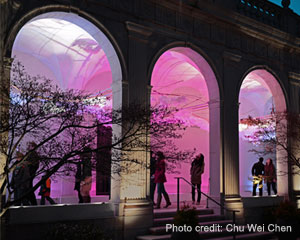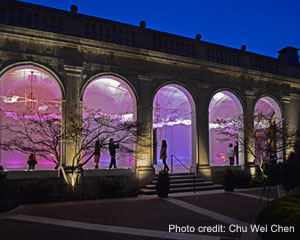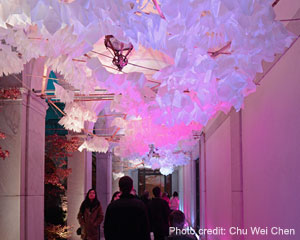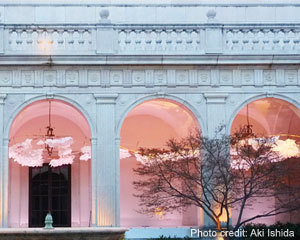Lantern FieldThe Smithsonian Freer Gallery of Art
Washington, D.C., USA
The use of LED lighting fixtures was instrumental in achieving Ishida's vision. Ishida's primary goal was to implement a lighting system that would enliven her creative design and allow visitors to engage with their environment in a meaningful way. But she also had to take more practical matters into account. The Philips Color Kinetics fixtures Ishida decided to specify would not only provide rich light, but possessed much cooler beams of light than conventional fixtures, ensuring the safety of visitors who might wander near the ground-level fixtures. In addition, the LED fixtures would consume significantly less power than conventional lighting fixtures.
The resulting installation featured mulberry paper to augment the light — a tradition in Japanese architecture. Freer Gallery visitors decorated the paper during a day-long workshop held by the Virginia Tech students. The paper was then folded into floral, light-capturing "lanterns" and fastened to bamboo poles hung from the gallery's loggia. Ishida's engineering team mounted Philips Color Kinetics iW Burst Compact Powercore and 2 ft ColorGraze Powercore fixtures in rows of plywood boxes along the ground, aiming them upwards to bring out the texture of the lanterns and reflect light off of the vaulted stucco ceiling. The ColorGraze Powercore fixtures were positioned along the gallery wall, while the iW Burst Compact Powercore fixtures lined the base of the archways.
By integrating the versatile Philips Color Kinetics fixtures with a third-party control and motion sensor, lighting programmer Brennon Bortz configured the lights to change color in response to visitors' presence and movements. For example, as the sensors detected people in the space, the ColorGraze Powercore fixtures produced a sweep of rose-tinted light along the lanterns that oscillated in tandem with the rhythms of electronic bamboo chime sounds, achieving the team's envisioned multi-sensory experience — and earning the installation a design award from Architectural Lighting magazine.














